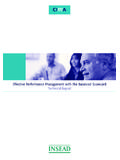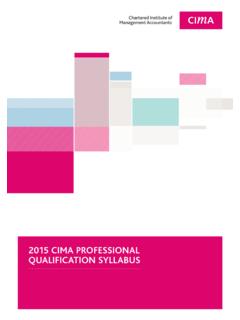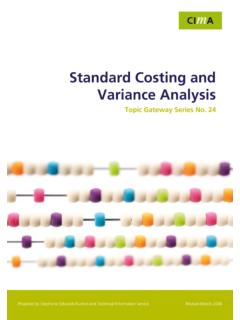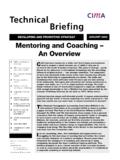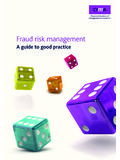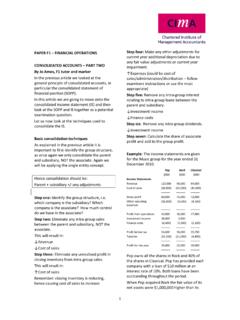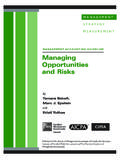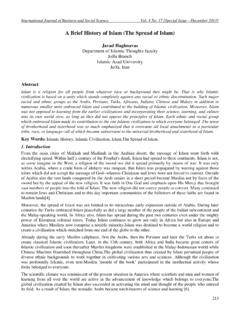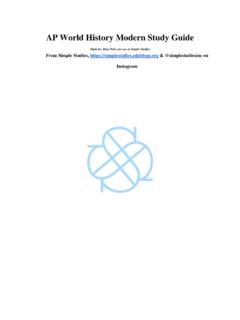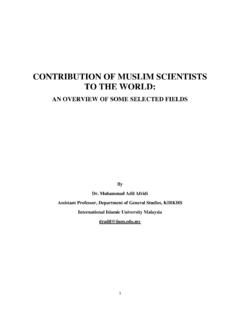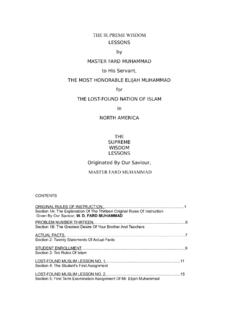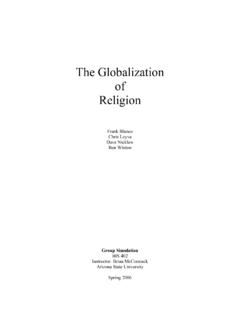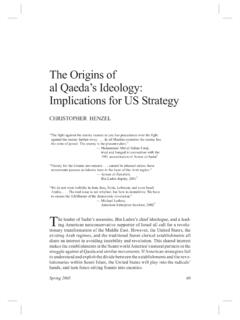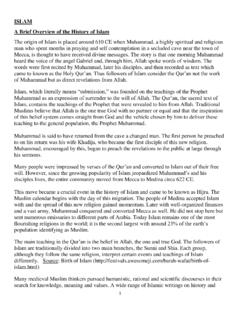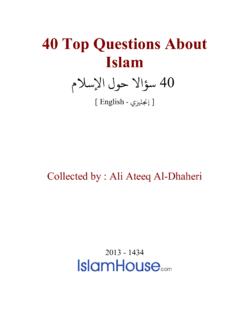Transcription of AN INTRODUCTION TO ISLAMIC FINANCE - CIMA
1 AN INTRODUCTION TO ISLAMIC FINANCEWELCOMEThe following guide has been created to introduce you to the exciting developments currently taking place in ISLAMIC FINANCE . The past 30 to 40 years has seen dramatic changes in this sector of the FINANCE industry with a marked growth in both the demand for and the provision of products and services. The ISLAMIC FINANCE industry is still growing at an exceptional rate as more companies expand into or further develop their offerings in this know how ISLAMIC FINANCE may impact you or your business efforts and what opportunities it may pose you need to understand the basic principles. We hope that this brief INTRODUCTION will help you on your out more about what support CIMA can offer on ISLAMIC FINANCE at was always interested in moving into ISLAMIC FINANCE by my personal preference and the career opportunity available in this fast growing Moinuddin,Senior Manager, FINANCE , HSBC AmanahNow a dynamic area of the international financial services sector and with a rising demand for a more ethical approach to FINANCE .
2 ISLAMIC FINANCE is set to continue increasing in importance over the next the successful review of the original CIMA Certificate in ISLAMIC FINANCE we took the opportunity to develop the structure of the qualification and how it is offered to reflect the changing requirements for ISLAMIC FINANCE in business. In addition to being able to complete the CIMA Advanced Diploma in ISLAMIC FINANCE , students can now specialise in areas of their choice which provides a more relevant and focused learning and development. CONTENTSW elcome 1. INTRODUCTION 4 ISLAMIC tradition 5 The meaning of ISLAMIC FINANCE 62. The components of ISLAMIC FINANCE 7 Banking and interest (Riba) 7 ISLAMIC banking the relationship between the user and the supplier of funds 7 Takaful ISLAMIC insurance 8 ISLAMIC capital markets 83.
3 The salient features of ISLAMIC FINANCE 9 Interest free 9 The need for underlying assets 9 The avoidance of uncertainty or gambling 9 Profit and loss sharing 9 Rights and liabilities of banks and customers 10 Shari ah compliance 10 Unlawful goods or services 10 Overriding principles of ISLAMIC law 104. Riba and Gharar 11 Riba 11 Gharar 125. Profit and loss sharing 136. ISLAMIC FINANCE compared with conventional FINANCE 147. Shari ah compliance and the equity market 148. Key issues 15 Prohibited trading items 15 Acceptable practice 15 Major contacts used 16 9. Requirements for sustained growth 1710. What if? 17 The credit crisis 17 Increasing cost of food staples around the world 1711. CIMA qualifications in ISLAMIC FINANCE 18 Certificates in ISLAMIC FINANCE 18 CIMA Diploma in ISLAMIC FINANCE (CDIF) 19 CIMA Advanced Diploma in ISLAMIC FINANCE (CADIF) 19 Fees 2045sign of reducing in the short to medium-term.
4 It is estimated that assets in the industry will reach $1 trillion by the end of 2010. This continued growth has been spurred by the actions of many governments around the world keen to see ISLAMIC FINANCE develop. The UK government in particular has already publicly backed growth in this sector, introducing changes to Stamp Duty rules to facilitate the growth in the ISLAMIC mortgage market and the promise of the issue of a UK sovereign Sukuk (bond). ISLAMIC FINANCE , while emerging over the past four decades, has its roots in the past as well as the present. These links to the past relate to the fact that it is based on principles and features which were established more than 1,400 years ago. Its links to the present relate to the fact that these ancient features are now being presented to contemporary society in a form which is both modern and innovative.
5 ISLAMIC FINANCE is distinct from conventional FINANCE in many respects but has a common goal in achieving the same economic benefit as conventional FINANCE offers to ISLAMIC TRADITIONThe essence of islam is that it derives its principles and values from the Qur an and the Traditions of the Prophet Muhammad. The history of ISLAMIC law begins with the revelation of the Qur an which contains legal principles and injunctions dealing with subjects such as ritual, marriage, divorce, succession, commercial transactions and penal laws. In contrast, the Traditions of the Prophet Muhammad record the sayings, actions and tacit approvals of the Prophet Muhammad. The literature of the Traditions of the Prophet Muhammad covers a much wider range of topics than the legal verses in the Qur believe that islam starts from a given or self-evident premise, namely the revelation.
6 It was with the ISLAMIC FINANCE , despite its name, is not a religious product. It is however a growing series of financial products developed to meet the requirements of a specific group of people. Conventional FINANCE includes elements (interest and risk) which are prohibited under Shari ah law. Developments in ISLAMIC FINANCE have taken place to allow Muslims to invest savings and raise FINANCE in a way which does not compromise their religious and ethical is estimated that between and billion people (one quarter of the world s population) are Muslim. Geographically, most Muslims live in Asia (over 60%) or the Middle East and North Africa (about 20%). Despite these figures, ISLAMIC FINANCE is still very much a niche market, with the vast majority of Muslims, who have access to FINANCE , using conventional financial products.
7 The following map shows the geographical spread of the Muslim population throughout the world as a percentage of each country s population, with the highest concentration in the darkest shades of most think of islam as being focused in the Middle East and South East Asia, the vast majority of Muslims live outside of these two regions. Some examples are referenced in the table ISLAMIC FINANCE is a relatively small player in global terms, most commentators agree that the current growth of between 15% and 20% in this niche market shows no Muslim percentage of population in each country (%)90 10075 9050 7525 505 251 50 1 World map showing figures sourced from: Miller, Tracy, ed. (October 2009) Mapping the Global Muslim Population: A Report on the Size and Distribution of the World s Muslim Population, Pew Research CenterSource: Miller, Tracy, ed.
8 (October 2009), Mapping the Global Muslim Population: A Report on the Size and Distribution of the World s Muslim Population, Pew Research CenterINTRODUCTIONTABLE 1:COUNTRY MUSLIM POPULATION% OF COUNTRY TOTAL POPULATIONC hina21,667, ,945, ,482, Lanka1,711, ,647, populations in Middle East and South East AsiaMalaysia16,581, ,504, PERCENTAGE OF POPULATION IN EACH COUNTRY67aim of directing and guiding humanity to the realisation of its moral potential and worldly worth that islam undertook to create a system known as the Shari ah. Shari ah refers to commandments, prohibitions, guidance, and principles under islam and is the clear path for believers to follow in order to obtain guidance in this world and deliverance in the Shari ah provides guidance in terms of belief, moral conduct and practical rulings or laws.
9 According to islam , a complete system of life is based on both legal prescriptions and moral and good conduct. Moral values have been incorporated as legal requirements in some specific contracts such as Amanah (honesty) in Murabahah (mark-up) financing. Other principles of moral values pertaining to commercial transactions include: Timeliness in the payment of debt or delivery of an asset. The failure to observe this aspect might involve legal consequences. Tolerance in terms of bargaining, where the parties are encouraged to be considerate to other s requirements and circumstances. Mutual revocation of a contract on request by one party if one party finds him or herself uncomfortable with the outcome of the transaction. Honesty or Amanah in all statements, representations and principles are not meant to be exhaustive but rather to highlight areas where, according to islam , morality is relevant in commercial dealings.
10 THE MEANING OF ISLAMIC FINANCEI slamic FINANCE is a term that reflects financial business that is not contradictory to the principles of the Shari ah. Conventional FINANCE , particularly conventional banking business, relies on taking deposits from and providing loans to the public. Therefore, the banker-customer relationship is always a debtor-creditor relationship. A key aspect of conventional banking is the giving or receiving of interest, which is specifically prohibited by the Shari ah. For example a conventional bank s fixed deposit product is based on a promise by the borrower to the bank to repay the loan plus fixed interest to the lender (the bank) that is the depositor. Essentially, money deposited will result in more money which is the basic wealth-producing structure of interest-based other non-banking businesses, conventional products and services, such as insurance and capital markets could be based on elements that are not approved by Shari ah principles such as uncertainty (Gharar) in insurance and interest in conventional bonds or securities.

